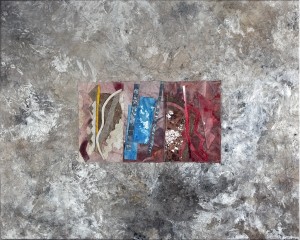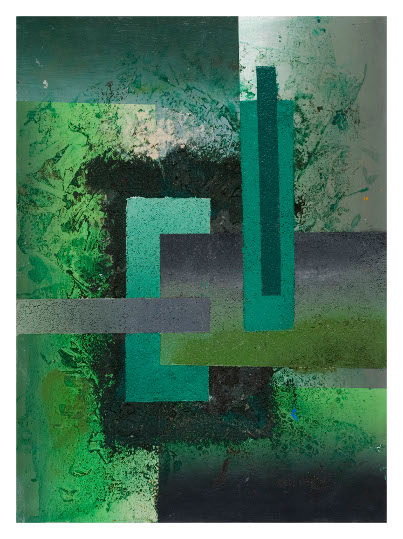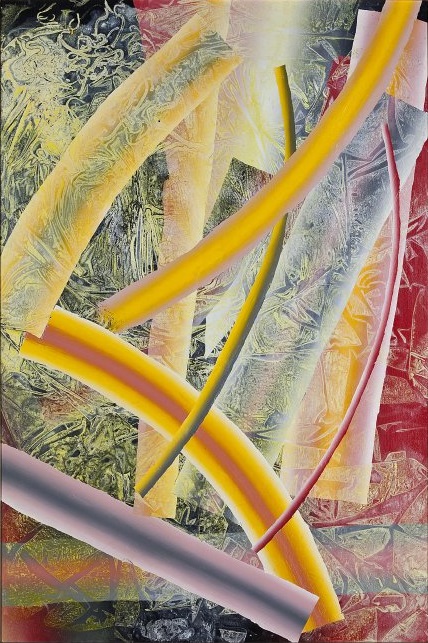
Bill Hutson
Defence Colony Series #10, 2002.
About:
Bill Hutson (1936) is essentially a self-taught artist, archivist, and educator who has traveled extensively for exhibitions and research. Since Hutson’s father, a musician, died when he was only four, Hutson doesn’t recall any creative impulses generated by him. However, it was when his mother became ill when he was about twelve years old that Hutson began to draw as a way of adjusting to a complex and distressing period of his life.
French Roast Series #19.
After her death in 1952, Hutson found solace in a loving and supportive extended family and a correspondence class in art and design. But it would not be until his early twenties that Hutson would become aware of the possibilities ‘fine art’ presented. After graduating from high school in 1954, Hutson entered the Air Force and it was there that he discovered what the world had to offer outside of San Marcos, Texas.
French Roast series # 22.
By 1960, Hutson had moved to San Francisco and was occasionally taking classes at the San Francisco Academy of Art where, working with Frank N. Ashley, he learned European art history, landscape, still life, and portrait painting. However, Hutson still felt the need to explore different techniques and forms to respond to his vision and sensibility. Hutson found his ‘creative language’ in abstraction.
Hutson went to New York in 1963 and from there began his vast travels. During the next four decades he visited more than twenty-two countries and lived in England, France, Holland, Italy, Nigeria, and Senegal. It was during his migration between London, Paris, and Amsterdam from 1963 to 1970, that he began meeting period abstractionists such as Edward Clark, Joan Mitchell and Sam Middleton. Hutson began intensely studying African philosophies and translating that study into his art. By 1971, when Hutson returned to America briefly, he was committed to exploring abstraction to its fullest and began to experiment with different kinds of materials and painterly processes. Hutson’s travels persisted and lead him to many cities in Western Europe, the Middle East, West Africa and recently to India, Thailand, Cambodia, Laos, Vietnam and Myanmar (Burma).
Kerala Series # 9, 2003
These travels have led Hutson to consider abstraction not only as a method of painting, but also as it appears in architecture and other three-dimensional forms. While his extensive travels have exposed him to many forms of abstraction that influenced his own processes of creating art, Hutson sees art not as political expression capable of proclaiming ones identity, but as a nonrepresentational exploration of color, texture and natural forms. Although some of his early works does indeed address issues of identity through the use of African signs, symbols and motifs, Hutson has declared that his art is essentially “about color and the juxtaposition of pattern and texture to compose and arrange materials and space until it achieves an emotional resonance.”
In the “French Roast Grounds Series” Bill Hutson brilliantly explores texture and the juxtaposition of light and geometric shapes. The intense aesthetic quality of this series is heightened by an extraordinary use of color and the multitude of spatial illusions created by layers of paint that create low-relief surfaces. In these paintings geometric composition suggests a kinetic force of light. Hutson is truly finding his place among abstract masters.
Ten Series # 8, 1993.
Throughout his career, Hutson has firmly established himself in the arts community not only as an abstractionist, but also as a teacher, historian, and curator. During the past thirty years, he has participated in more than twenty solo museum and gallery exhibitions and in over fifty group shows. His abstract paintings and painted objects are in numerous private and public collections. Hutson’s current art is rarely available to private collectors.
Hutson has received prestigious awards including the Cassandra Foundation Award and a National Endowment for the Arts Fellowship. He has also been a guest speaker and educator at numerous institutions including the University of Paris-Sorbonne Nouvelle, Ecole Nationale d’Art et Manufacture in Libreville, Gabon and Casuarina, India Habitat Center in New Delhi, India. (text and courtesy Lana Woods gallery)




